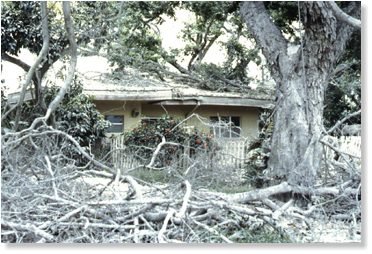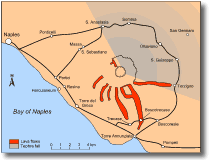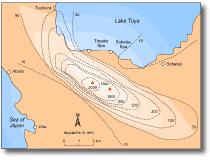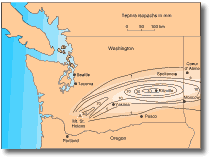
Tephra Falls
Fatalities Tephra falls, although being a common volcanic hazard, cause relatively few deaths (4-4.3% of volcano-related deaths in the historical record, Table 6, Section 2). Even when tephra falls are very thick, if roofs remain intact and toxic volcanic gas content is low, the chances of survival are high. Near Vesuvio volcano (Italy), tephra falls have directly caused a large number of deaths. In AD 79 an eruption buried the city of Pompeii. Estimates of the death toll are highly variable, but of around 2700 deaths, a few hundred are probably due directly to the tephra fall. The tephra fall deaths apparently resulted from crushing by collapsing roofs and asphyxiation. Many of the other deaths were due to a later pyroclastic surge and noxious gases associated with the tephra. Importantly, some people survived as much as 2.8 m of tephra fall during this event, only to be later killed by a pyroclastic surge. Ottaviano was severely affected with tephra thicknesses estimated between 0.6 and 7 m causing collapse of roofs and up to 200 deaths. At San Guiseppe a further 105 were killed and 90 more injured when the roof of the church of their patron saint, in which they took shelter, collapsed. A further 29 people were killed in San Gennaro. Survivors reported no asphyxiating gases. In 1944, a further eruption of Vesuvio caused 26 deaths, 21 attributed to roof collapse under tephra fall. In a New Zealand example, 108 people were killed in the villages
of Te Ariki, Moura, and Te Wairoa when their roofs collapsed under
the load of tephra erupted from Tarawera volcano in 1886.
Acute medical effects Tephra falls may affect eyes and respiratory systems as has been reported in historical examples. In 1902 before the climactic eruption of Mont Pelée, residents of St. Pierre found breathing increasingly uncomfortable, and had sore eyes and throats as ash fall steadily increased over a period of days. In Kodiak, downwind of the 1912 Katmai-Novarupta eruption, babies suffered from running noses, severe coughs and eyes full of mucus in the week following the eruption. After the eruption of Karkar (Papua New Guinea) many people in an area of 10-20 mm of tephra fall were treated for upper respiratory tract infections and diarrhoea. However, in many historical cases, the medical effects of tephra falls appear to be proportional to the amount of scientific study carried out. Irazú (Costa Rica) erupted almost continuously from 1963 to 1965, with numerous ash falls on the capital city of San José, 30 km west of the volcano. Acute conjunctivitis was caused by ash grains in the conjunctival sac, leading to redness and irritation of the eyes. Throat irritations, inflammation and burning were also common. These complaints rapidly cleared up after exposure to ash fall ceased. Some people suffered nasal irritation and discharge with respiratory infection which caused longer periods of stress. People with pre-existing chest complaints developed severe bronchitic symptoms that persisted for days following ash fall. None of the effects were serious enough to cause any deaths. Following the 1980 Mt. St. Helens tephra fall there was a high intensity of investigation of the medical effects. Hence, the heath concerns cover a great range of ailments even though the tephra falls were in most cases relatively thin, mostly <15 mm (Fig. 10). Emergency room visits increased in other towns also, but the number of visits varied depending on stress reactions, pollen and allergy problems, weather, changes in work patterns, and numbers of people driving vehicles. Nevertheless, medical services still had to cope with the increased visits. In Yakima, of 129 patients with eye-related problems between May 18 and June 14, 42 were ash related. Ten of the 42 patients were under 15 years old and were playing in or throwing the tephra when the eye problems occurred. Of the 32 adults, 11 were involved in clean-up operations, and a further 7 were riding on or in vehicles. The 42 patients exhibited one or more of the following conditions; foreign body sensations, itchiness and redness, tearing, swelling, abrasion or scratches, or conjunctival injection/edema. A telephone survey of several ash-affected communities revealed that 4-8% of the population experienced some degree of eye irritation, although only one in ten of these people sought medical advice. Some people exposed to tephra fall and the clean-up process suffered skin irritation, although this was not serious or chronic, many people suffered from “ash-rash” when the skin absorbed fine ash. Other indirect medical effects included a drop in the number of recreational injuries (because these activities were impossible for a period), but a rise in the number of motor vehicle accident injuries plus injuries due to falling from roofs. The proportion of the population in an area reporting medical effects of tephra falls is largely dependant on the development of the society and availability of medical services. In addition, the period of exposure to ash, weather conditions, grain size of tephra, and the presence or absence of irritant gases (e.g. SO2) have variable impacts. Chronic medical effects When breathing an ash-laden atmosphere there is a chance of contracting chronic bronchitis, pneumo(vol)coniosis, or silicosis. Silicosis is a lung disease resulting from inhalation of fine free crystalline silica particles. A victim must be exposed to crystalline quartz, tridymite or cristobalite in a respirable particle size of <10 m m. Inhalation of any toxic dust (e.g. talc, silicates etc.) can cause pneumoconiosis. Most inhaled dust is captured by the upper respiratory defence system and/or exhaled. However, the fine material lodges deep within the lungs and encourages, after exposure for a year or more, silicosis or pneumoconiosis. In the U.S. it is recommended that the total suspended particulate concentrations in a working environment should be < 1000 m g/m3 to avoid significantly harmful effects for long periods of exposure. The level of free silica in the air should be < 50 m g/m3. During tephra fall in Yakama (of the 1980 St. Helens eruption), particle concentrations reached > 35 000 m g/m3, and five days after the eruption, levels still exceeded 1000 m g/m3. Between 4 and 6% of the tephra was free crystalline silica < 10m m. However, despite these high levels, only those exposed for long periods to high concentrations of respirable tephra (e.g. forestry workers), were at risk of developing pneumo(vol)coniosis. Rats that were dosed with 10 mg of respirable tephra (7.2% crystalline silica) had acute swelling in small areas of their lungs after a day. Surface lung damage radiated outward from these areas over the next few months. Similar effects were observed in one of the forestry workers killed in the lateral blast of the St Helens eruption. Protective measures A variety of protective measures have been devised by populations affected by tephra falls. During the 1906 eruption of Vesuvio, citizens of Naples wore heavy overcoats, glasses or goggles and carried umbrellas extended in front of them while walking through ash fall. At Barbados during the 1902 Soufriére eruption, people used sunglasses and veils to protect themselves from the fine tephra fall. In Anchorage (Alaska), after the 1953 eruption of Spurr, newspaper delivery boys used surplus army masks during their rounds. In San Jose (Costa Rica), 230 000 inhabitants were forced to wear goggles, bandanas, and even gas masks almost every day of the continuous eruptions of Irazú from 1963-1965. During the May 1980 St. Helens tephra fall, much contradictory advice was given. Citizens of Ritzville (Fig. 10), were told to wear wet cloth masks to filter out soluble gases and tephra, only to be later told that dry cloth was better, and then later wet cloths were again recommended. People were told to drink clear fluids like water or tea, rather than hot chocolate or milk which apparently causes mucus build-up and attracts dust. People with respiratory problems were told to moisten the air by turning on the shower or a steam kettle. The Federal Emergency Management Agency produced a series of bulletins to advise the public how to handle tephra and what to do in tephra falls. The general public were advised to remain indoors during ash fall and wear a light face mask if outdoors. In particular it was advised that children should be kept inside during ash falls and should avoid strenuous play or exertion (to avoid heavy or deep breathing). If no masks were available, wet cloths were recommended as makeshift masks. Tephra and aviation hazards In 1982, in two separate incidents, Boeing-747 aircraft ran into ash clouds drifting southwest of Galunggung volcano in western Java. Both aircraft encountered the ash at night at altitudes of c. 37,000 feet (11,300 m) and suffered multiple engine failures. Once the aircraft glided to lower altitudes out of the ash cloud, their engines could be restarted and they made emergency landings at Jarkarta. Later, in 1983 an aircraft on a course to avoid Galunggung, ran into an ash cloud from Colo volcano in Indonesia. Soputan volcano in Indonesia has also caused damage to aircraft in 1985. Alaskan volcanoes have also affected aircraft since at least 1955, when a Mt Spurr eruption damaged U.S. airforce aircraft. Aircraft were also affected in the 1976 and 1986 eruptions of Augustine volcano in Alaska. The 1980 St Helens eruption caused considerable disruption to airports and some cases of aircraft engine failure. Kagoshima airport, located 24 km from the active Sakurakima volcano, had eight incidents between 1975 and 1986 where aircraft flew into ash clouds and were damaged. High altitude ash clouds dominantly comprise glassy and silicate particles which are highly abrasive. These can severely damage aircraft, particularly highly tuned jet engines where exposed surfaces are eroded. Silicate particles, when mixed with air intake, can also be melted in the combustion chamber of the engine. The molten ash is deposited as a ceramic-like substance on turbine blades, restricting air-intake and leading to compressor stall (as occurred in the two aircraft at Galunggung in 1982). Ash particles also cause abrasion to the leading edges of wings, nose cones, landing lights and windscreens (so that pilots can no longer see through them). The abrasion is accompanied by static electrical discharge. Ash can block the systems measuring airspeed, and can affect cabin pressurisation and air-conditioning systems. Acid aerosols contained in ash clouds can also cause corrosion to susceptible parts. Sulphur dioxide (SO2), which oxidises to sulphuric acid (H2SO4) persists for long periods in the atmosphere, particularly above the tropopause in the stratosphere. Several aircraft on polar routes (where the tropopause is lower) have suffered chemical attack, including damage to acrylic windows. Remote sensing equipment is used to detect long lived aerosols and these can be avoided on flight routes. However, the more damaging, dense ash clouds which may be only a few hours or minutes old pose a greater problem. In areas where there are slow communication links between volcano observers and aviation authorities, this problem is exacerbated. Ash clouds may rise to aircraft-cruising altitudes within minutes and yet aviation authorities may not know until hours later. A further difficulty is that ash clouds at night can be concealed by normal weather clouds and remain unseen. Ground-based radar can detect ash clouds, but the low power radar carried by aircraft cannot because of the low-reflection properties of ash clouds. Pilots are unaware of the cloud until engines begin to surge and static-electrical discharge is seen on the leading surfaces. Ash clouds can persist for hours to days following an eruption and can drift hundreds of kilometres from source. Hence, avoidance of the volcano may not be sufficient, the trajectory of the ash cloud must also be tracked. Advisory groups have been established by aviation authorities to investigate mitigation measures and procedures to deal with ash cloud hazards. These groups have recommended the use of satellite imagery to detect and track the trajectory of eruption clouds. Meteorological satellites have proved useful for tracking eruption clouds, but they cannot distinguish these from normal weather clouds. Polar-orbiting TIROS-series satellites carry multi-spectral scanners and have potential for detecting ash clouds. In addition, the Nimbus-7 satellite caries a total ozone mapping spectrometer (TOMS) that can distinguish SO2-bearing eruption clouds from ozone and weather clouds. However, these satellites only provide images on 12 hourly overpasses and there are long image processing delays, limiting their usefulness for early warning purposes.Satellites would be more useful for detection of ash clouds if geostationary satellites (those which orbit in time with the earth and always image the same portion of the globe), carried multi-spectral scanners or TOMS equipment. These would be even more effective if an alarm system could trigger a real-time down-link to aviation authorities. In the interim, however, improvements can be made to warning times by improving communication links between volcano observers and aviation authorities and by developing on-board ash cloud detectors on aircraft. Devices such as infrared scanners, electrical field detectors, and multi-channel radiometers could potentially be used.
|
|||||||||
|
|||||||||





